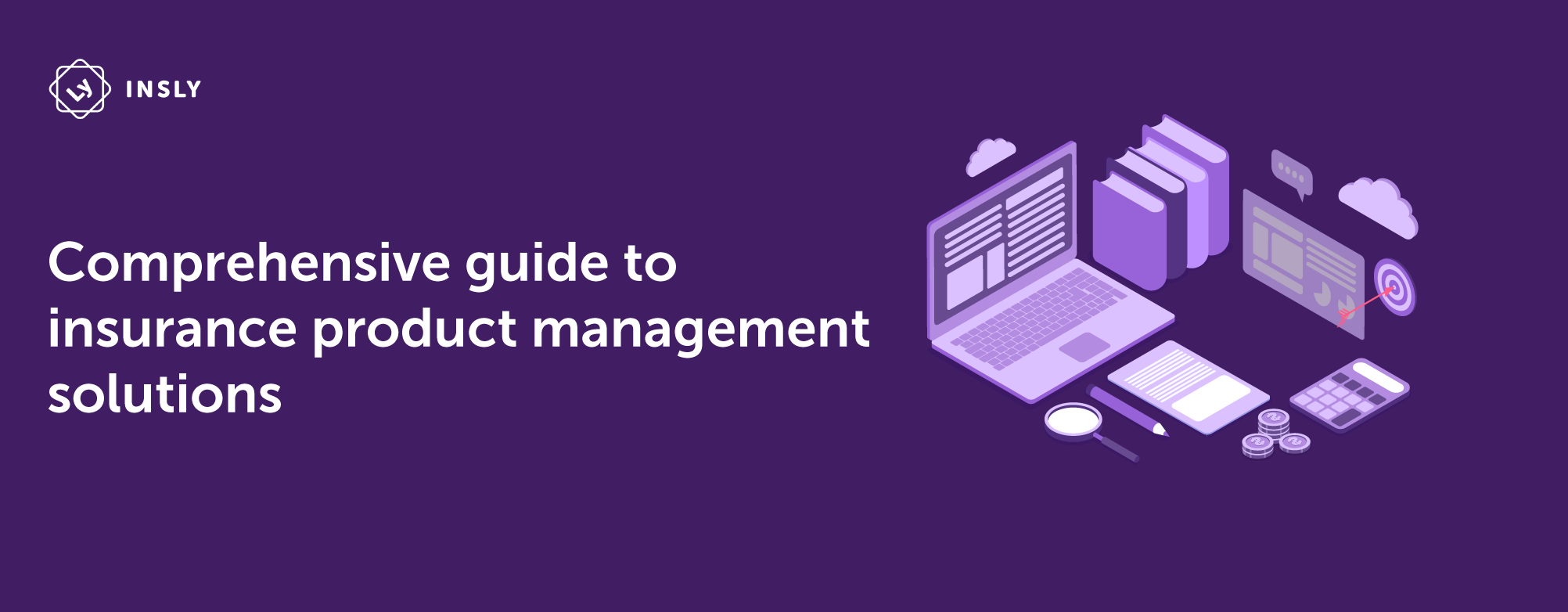The evolving risk landscape, increasing customer demands, and fierce competition mean insurance product management is critical to the success of MGAs and insurers. These businesses must consistently offer insurance protection that customers need, at the right price, in an appealing way, to ensure they continue to acquire market share and drive revenues and growth.
But insurance product managers face numerous obstacles in achieving those aims, which hinder innovation, and make product development and optimisation cycles overly long and convoluted. To get ahead, MGAs and insurers must proactively enhance their product management practices and strategies to launch better and more profitable products faster, while providing a top-class customer experience.
This article provides an overview of the steps MGAs and insurers can take to build an industry-leading product management process.
What is Insurance Product Management?
Insurance product management spans anything involved in developing, launching, and optimising insurance products. This includes:
- Analysing data to identify market trends and customer needs
- Working with underwriters to develop the product, points of differentiation, and policy wording
- Developing pricing
- Securing reinsurance partners where required
- Developing a distribution strategy – will products be sold directly or via brokers?
- Performance monitoring and optimisation
Product managers in insurance must be adept at analysing market trends, identifying opportunities for innovation, and developing products that meet customer demands and business objectives. In recent years, insurance products have emerged covering risks ranging from drones to cannabis, cryptocurrency to the gig economy, and everything in between. These have all resulted from product managers and underwriters spotting new customer demands and designing products to meet them.
Alongside a keen eye for trends, insurance product management also requires a good understanding of risk assessment and mitigation, working closely with actuaries and underwriters to ensure products are priced appropriately and the company’s risk exposure is managed effectively. Insurance product managers must also stay abreast of emerging technologies, such as telematics, the Internet of Things (IoT), wearable tech, and AI, that could disrupt the market or create new opportunities to innovate how products are delivered, how risks are monitored, or claims paid out. These can all give insurance companies a vital point of differentiation.
The product management challenges faced by insurers and MGAs
In an already complex market, product managers must contend with multiple diverse stakeholders, data siloes, and legacy systems, making product management hugely time-consuming and inefficient. A study by Deloitte found that new insurance products can take between 12 and 18 months to launch and, with the rate of change in the risk landscape, MGAs and insurers need to accelerate this process, to respond to customer demand faster and get ahead of the market.
Added to this, product managers face ever-increasing customer expectations regarding service and convenience. Customers expect to be able to purchase insurance coverage at any time, via any channel, with flexibility over contract length and policy scope, while avoiding any jargon and complexity. This requires MGAs and insurers to modernise how they work, taking a customer-centric rather than a product-centric view that responds to rapidly evolving customer needs.
Key strategies for effective insurance product management
Utilise roadmaps for strategic planning
Product roadmaps are essential for aligning stakeholders, providing context for product decisions, and guiding the entire product lifecycle. A well-crafted roadmap should not only map the product development trajectory but also align with the company’s overall business strategy and market positioning.
It also enables companies to plan resourcing and skills needs across three levels of product development activities: Developing new products; product refreshes; and ongoing tweaks and optimisation. A detailed product roadmap enables MGAs and insurers to coordinate teams around these three priorities, ensuring nothing gets overlooked.
All relevant stakeholders should be involved in creating a roadmap, including underwriting, claims, sales, and customer service departments. This collaborative approach ensures the roadmap reflects a holistic view of the product’s potential impact across the organisation.
A product roadmap should incorporate the following:
- Start with a clear vision and rationale
- Conduct conversations with all stakeholders before beginning
- Use themes instead of specific features to elevate discussions
- Include different tracks for different types of product development, e.g. new product, product revamp, or product tweak.
- Include cybersecurity and regulatory compliance as consistent themes, reducing the risk of non-compliance or security vulnerabilities.
Update legacy infrastructure and leverage low-code product builders
Updating inflexible legacy systems is one of the fastest ways to accelerate product development. There are now a range of innovative alternatives available, which are fast to implement and simple to use.
For instance, low-code product builders are revolutionising insurance product management by democratising the product development process. These tools empower product managers and business users to create and modify insurance products without extensive coding knowledge, significantly reducing the time and resources required. Where traditional insurance product development would often involve lengthy IT queues and complex development cycle, these tools free up IT resources for more complex tasks and reduce bottlenecks.
With these modern platforms, product managers can rapidly prototype, test, and launch new products or product variations, to respond quickly to market changes, customer needs, or competitive pressures. This flexibility is invaluable, where products often need to be tailored for different markets, distribution channels, or regulatory environments. Product managers can easily create variations of existing products or make quick adjustments in response to market feedback.
Prioritise data integration and API connectivity
In modernising systems, MGAs and insurers should also focus on data integration and API connectivity, so they can seamlessly connect and share data across various systems and partners to enhance product management and operational efficiency.
Access to joined-up data is critical for understanding customer needs, as well as developing and testing new products. Tracking a diverse range of data also enables ongoing optimisation of existing products, showing what elements are working, and where tweaks are needed.
Systems that link up to third-party databases for underwriting enrichment are also becoming increasingly important in risk assessment and pricing. By integrating with external data sources such as credit bureaus, motor vehicle records, or property databases, insurers can make more informed underwriting decisions, potentially offer more competitive pricing, and streamline the application process for the customer.
API-driven connectivity enables real-time data flow between systems, which is essential for creating a seamless customer experience and improving operational efficiency. Moreover, robust API connectivity can facilitate the creation of insurance ecosystems and embedded insurance, where multiple services and products can be integrated to provide comprehensive solutions to customers. This can open up new revenue streams and enhance customer loyalty by offering a more holistic suite of services.
Embed product innovation in the business and embrace agile
Rapid product development is only possible if product management and innovation teams are fully integrated and aligned. Otherwise, the result is mismatched objectives, long delays, and ineffective products. To avoid this, companies should consider building multifunctional product management teams and adopting agile methodologies, which offer a flexible and responsive approach to product development in a rapidly changing market.
Iterative development cycles are at the heart of agile methodologies. Instead of following a traditional waterfall approach with long development cycles, agile working breaks down product development into smaller, manageable chunks. This allows for more frequent releases and the ability to pivot quickly based on feedback from customers or internal stakeholders, or changing market conditions.
Agile product management is also helpful for prioritising features based on business value and customer needs, ensuring development efforts are focused on the most impactful features, maximising return on investment. It also aids with managing stakeholder expectations by clearly communicating the rationale behind decisions.
Focus on customer-centric design
Customer-centricity is paramount in today’s insurance market, where customer expectations are increasingly shaped by experiences in other, more digitally advanced industries. Focusing on user-friendly design and the customer experience can significantly impact customer acquisition, retention, and overall return on product development investment.
Insurers and MGAs have historically been limited in customer touchpoints; effectively purchase, renewal, or claims. However, digital technology has allows companies to enhance the customer experience in a variety of ways, most notably in helping with risk prevention. Now, IoT devices, wearables, and other data sources can help customers track and manage their risk exposure, enhancing their relationship with their insurer. For example, this is being done effectively by cyber security MGAs, which offer cyber security measures and tools alongside traditional protection.
Insurance companies can also differentiate their products by creating intuitive user interfaces for partners and customers to simplify complex insurance concepts, make it easier to understand coverage options, and make informed decisions. Streamlining the quote and bind process is a key area where customer-centric design can have a significant impact by reducing the number of steps required, pre-filling information where possible, and providing clear guidance throughout the process.
Similarly, automated underwriting, when implemented thoughtfully, can significantly enhance the customer experience by providing instant decisions in many cases. This not only speeds up the process for customers but also allows underwriters to focus on more complex cases that require human expertise.
Implement industry-specific metrics
Successful product management is only possible with the right metrics to measure what good looks like. Without meaningful KPIs, it’s impossible to assess product performance and identify areas for improvement. Some of the key metrics to track are:
- Policy retention rates to indicate product satisfaction and competitiveness.
- Retention rates to show if customers find value in the product and how this varies across customer segments.
- Customer satisfaction scores for claims processing, as the claims experience often defines a customer’s overall perception of the insurer.
- Conversion rates through the sales funnel show the effectiveness of product marketing and the sales process.
By tracking these metrics, product managers can demonstrate the value of technological investments and identify opportunities for further optimisation.
Invest in continuous learning and professional development
In the rapidly evolving insurance industry, continuous learning and professional development are essential for product managers to stay ahead of the curve. The convergence of technology, changing customer expectations, and evolving regulatory landscapes makes it crucial for insurance product managers to constantly update their knowledge and skills.
Attending insurance technology conferences is an excellent way to stay informed about the latest industry trends, innovations, and regulations, including cutting-edge technologies such as artificial intelligence, blockchain, and IoT applications.
Product management workshops can help insurance product managers refine their skills and learn new methodologies, such as agile product management, design thinking, and data-driven decision-making. Moreover, insurance product managers should consider pursuing relevant certifications or advanced degrees to deepen their expertise.
Quick tips for fast insurance product launches
Launching insurance products quickly and efficiently is becoming increasingly important in today’s fast-paced market. However, speed should not come at the expense of quality or compliance. Here’s a quick re-cap of these best practices:
- Define product objectives and scope before development begins: Carry out thorough market research, define product features and pricing, and align with regulatory requirements. It’s important to involve underwriting, claims, and legal teams early to ensure all aspects of the product are well-defined, to avoid costly delays and revisions later.
- Clarify target customers and their specific needs early: This includes not only end customers but also internal users such as underwriters, claims handlers, and customer service representatives. Understanding their workflows and pain points can lead to more effective product design, which truly meets these requirements.
- Re-engineer business processes for improved efficiency: This might involve streamlining underwriting processes, automating certain tasks, or redesigning customer interaction points. Being open to process changes can generate significant improvements in operational efficiency and customer experience.
- Partner with innovative insurtech partners: Low-code tools, such as Insly, allow business users to make changes quickly without relying heavily on IT resources. This enables faster response to market feedback or regulatory changes, and accelerates product development and modification.
- Utilise flexible, open solutions: Choosing the right partners facilitates easier integration with existing systems and future technologies. This significantly reduces time-to-market and allows for easier updates and modifications as market needs evolve.
- Create clear documentation and training materials: Ensure all users, internal and external, can effectively use and support the new product from day one.
- Consider implementing a phased launch approach: Start with a minimum viable product (MVP) and iterate based on market feedback. This helps get products to market faster while allowing for refinement based on real-world usage.
Product management, ready for the future
Effective insurance product management combines industry expertise, strategic thinking, and technological savvy. By implementing these strategies and best practices, insurance professionals can drive innovation, improve operational efficiency, and deliver products that meet the evolving needs of their customers, ultimately benefitting the bottom line.
The insurance industry is undergoing a significant transformation, and it doesn’t look like slowing down any time soon, with trends such as AI, personalisation, ecosystem-based insurance, and sustainability all driving innovation in 2025. To navigate these trends successfully, insurance product managers need to continually update their skills, embrace new technologies, and maintain a deep understanding of both customer needs and market dynamics. By doing so, they can play a pivotal role in shaping the future of insurance and delivering value to both customers and their organisations.



